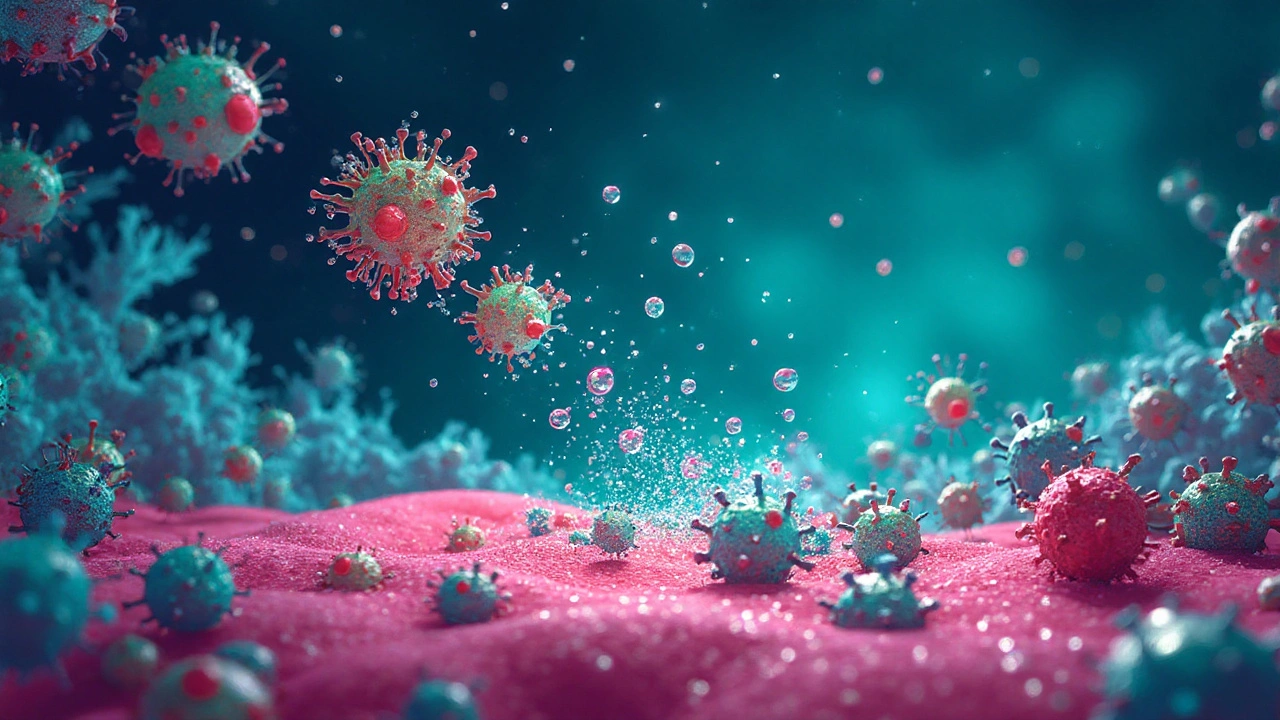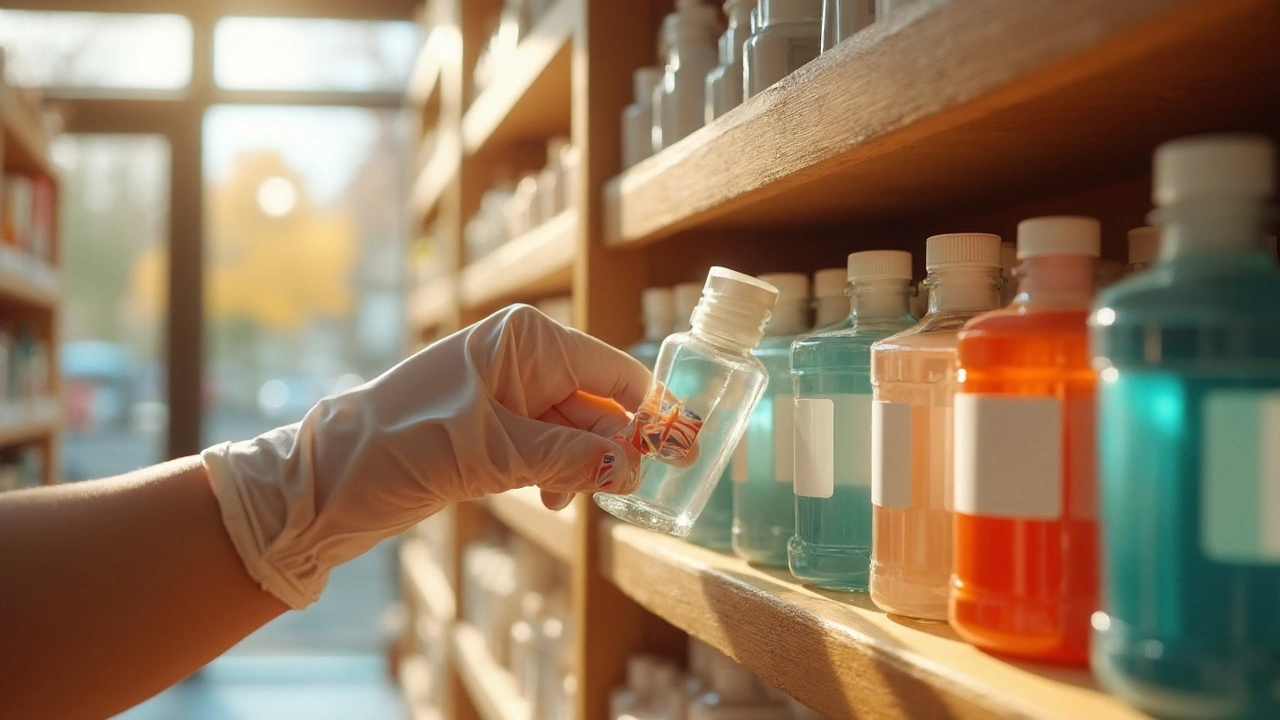Antiseptic Selector Quiz
Drugstore antiseptics are over‑the‑counter products designed to kill or inhibit harmful microorganisms on skin and surfaces. They range from liquid hand rubs to wipes and ointments, and most shoppers assume any product labeled “antiseptic” works the same. In reality, the active ingredients, concentration, and intended use vary widely, and only a subset meets the strict efficacy standards set by health authorities.
How Antiseptics Kill Germs
At the core, an antiseptic disrupts a microbe’s critical structures-cell membranes, proteins, or genetic material. Alcohol (typically ethanol or isopropanol) denatures proteins and dissolves lipid membranes, making it a fast‑acting broad‑spectrum agent. Benzalkonium chloride a quaternary ammonium compound interferes with membrane integrity but is slower and less reliable against certain viruses. Chlorhexidine a biguanide that binds to bacterial cell walls offers persistent activity, especially for surgical skin prep. Povidone‑iodine an iodine‑polyvinylpyrrolidone complex that oxidizes cellular components works on a wide range of organisms, including spores, but can stain skin. Finally, Hydrogen peroxide produces free radicals that damage DNA and membranes, making it useful for wound care but harsh on healthy tissue.
Common Over‑The‑Counter Antiseptic Types
- Alcohol‑based hand rubs - 60‑80% ethanol or isopropanol. Recommended by the CDC for routine hand hygiene.
- Benzalkonium‑chloride wipes - 0.1‑0.13% solution, often marketed for “non‑alcohol” sanitizing.
- Chlorhexidine gluconate solutions - 2‑4% for pre‑operative skin prep; also found in some acne wipes.
- Povidone‑iodine swabs - 10% solution, common in first‑aid kits.
- Hydrogen peroxide spray - 3% concentration for minor cuts.
Even though all carry the “antiseptic” label, their effectiveness hinges on concentration and contact time. A 30% ethanol wipe, for example, falls short of the CDC’s 60% threshold and offers minimal viral kill.
What the Science Says - Real‑World Efficacy Data
Multiple studies published by the FDA and WHO compare these agents. A 2023 FDA review of 12 hand‑rub products found that only formulations meeting or exceeding 60% ethanol achieved >99.9% reduction of SARS‑CoV‑2 within 30 seconds. In contrast, benzalkonium‑chloride wipes in the same review showed a median 70% reduction, failing to meet the “high‑level disinfectant” benchmark for viruses like norovirus.
Chlorhexidine shines in surgical settings. A CDC surgical site infection (SSI) surveillance report (2022) recorded a 30% drop in SSIs when surgeons used a 2% chlorhexidine scrub versus plain soap. Povidone‑iodine maintains the broadest spectrum; a 2021 European Medicines Agency (EMA) assessment noted >99.99% kill of bacterial spores at 10% concentration, a level rarely achieved by alcohol alone.
Choosing the Right Antiseptic - A Practical Checklist
| Active Ingredient | Typical Concentration | Spectrum (B/V/F) | Contact Time* | Skin Tolerance | Regulatory Status |
|---|---|---|---|---|---|
| Ethanol / Isopropanol | 60‑80% | Broad (B/V) | 15‑30s | Good, may dry | FDA‑cleared (hand rub) |
| Benzalkonium chloride | 0.1‑0.13% | Limited (B) | 30‑60s | Excellent (low irritation) | EPA‑registered (disinfectant) |
| Chlorhexidine gluconate | 2‑4% | Broad (B, some V) | 20‑60s | Moderate (may sting) | FDA‑approved (pre‑op) |
| Povidone‑iodine | 10% | Broad (B/V/F) | 30‑90s | Variable (staining, irritation) | EMA‑monitored (wound) |
| Hydrogen peroxide | 3% | Moderate (B/V) | 1‑2min | Low (can damage healthy skin) | FDA‑OTC (antiseptic spray) |
*Contact time refers to the minimum duration the product should stay wet on the skin for optimal kill.
Use the table as a quick‑reference when you’re standing in the pharmacy aisle. If you need fast, broad‑spectrum disinfection for everyday hand hygiene, grab an alcohol‑based rub that meets the 60% threshold. For pre‑surgical skin prep or when you need lingering protection, chlorhexidine is the go‑to. When you’re treating a minor cut and want a one‑step antiseptic that tackles fungi and spores, povidone‑iodine wins despite the mess.

Safety, Irritation, and the Skin Microbiome
Repeated use of high‑concentration alcohol can strip the natural lipid barrier, leading to dryness, cracking, and increased susceptibility to dermatitis. Benzalkonium chloride is gentler, but some users report allergic contact dermatitis after prolonged exposure. Chlorhexidine may cause a temporary burning sensation; the CDC advises a rinse after 30 seconds for patients with sensitive skin.
Emerging research from the University of Edinburgh (2024) shows that over‑use of broad‑spectrum antiseptics can disrupt the skin microbiome, reducing beneficial Staphylococcus epidermidis populations. The practical takeaway: reserve the strongest agents for moments when you truly need them (e.g., after a puncture wound) and rely on gentler soap‑and‑water for routine cleaning.
Common Mistakes & Myths
- “All wipes are the same.” The active ingredient matters. A cheap “antibacterial” wipe often contains only low‑dose benzalkonium chloride, which may not inactivate certain viruses.
- “More is better.” Over‑dosing does not increase kill rate; it just heightens skin irritation.
- “Alcohol kills everything.” Alcohol is ineffective against bacterial spores and some non‑enveloped viruses; for those, consider povidone‑iodine or bleach‑based solutions (outside the drugstore range).
- “If it’s labelled ‘medical grade’ it’s safe for kids.” Concentrations safe for adults can be too harsh for children’s delicate skin. Look for pediatric formulations.
Quick‑Start Cheat Sheet
- Everyday hand hygiene: 60‑80% ethanol/isopropanol gel, keep it wet for 15‑30seconds.
- Pre‑surgery or invasive procedures: 2‑4% chlorhexidine gluconate, let dry 20‑60seconds.
- Minor cuts & grazes: 10% povidone‑iodine swab, apply and let air‑dry.
- Surface disinfection (non‑porous): Alcohol‑based wipes with ≥70% ethanol.
- Allergic or very dry skin: Choose benzalkonium‑chloride wipes or fragrance‑free alcohol rubs with added moisturizers.
When to Trust the Label - Regulatory Guidance
The U.S. Food and Drug Administration (FDA) requires that any over‑the‑counter antiseptic intended for hand sanitizing list the exact alcohol concentration on the label. For non‑alcohol products, the EPA’s “Antimicrobial Pesticide” registration number serves as proof of efficacy testing. The World Health Organization (WHO) also publishes two “Formulation1 &2” recipes for alcohol‑based hand rubs; any product that matches these formulas is judged equivalent to a hospital‑grade sanitizer.
In the UK and EU, the Medicines and Healthcare products Regulatory Agency (MHRA) and European Medicines Agency (EMA) oversee antiseptics that claim to treat wounds. If a product advertises “rapid wound healing” without an MHRA/EMA licence, treat it with skepticism.
Putting It All Together - What to Buy Today
Walk into any major UK or US pharmacy with this mental checklist:
- Read the active ingredient and concentration.
- Match the intended use (hand rub vs wound care vs surface wipe).
- Check for FDA/EPA/EMA registration numbers or WHO formulation claim.
- Consider skin tolerance-pick a product with added emollients if you have dry skin.
- Buy only what you truly need; avoid hoarding every bottle on the shelf.
Following these steps ensures you leave the drugstore with a product that actually works, rather than a fancy bottle that merely looks the part.

Frequently Asked Questions
Does a higher alcohol percentage mean better protection?
Up to about 80% the kill rate improves, but beyond that the extra alcohol actually reduces water content, which slows protein denaturation. The sweet spot for most pathogens is 60‑80% ethanol or isopropanol.
Are benzalkonium‑chloride wipes safe for kids?
Yes, they’re low‑irritant, but they don’t meet the CDC’s recommended efficacy against many viruses. For children, an alcohol‑based rub (if tolerated) or a pediatric‑specific formulation is preferable.
Can I use povidone‑iodine on a deep wound?
Povidone‑iodine is great for superficial cuts, but for deep or heavily contaminated wounds doctors often prefer chlorhexidine or sterile saline irrigation, followed by proper dressing.
Why do some hand sanitizers feel sticky?
Manufacturers add humectants like glycerin to prevent the skin from drying out. Too much glycerin makes the gel tacky; a balance (around 1‑2%) keeps hands moist without a sticky residue.
Is hydrogen peroxide safe for daily hand cleaning?
No. Even at 3% it can irritate the skin and isn’t as fast‑acting as alcohol. Reserve it for wound irrigation or occasional surface disinfection.


